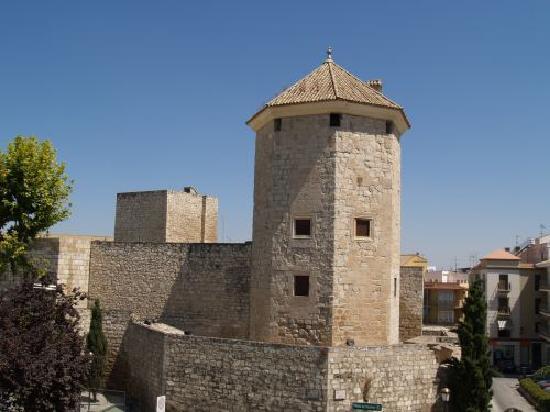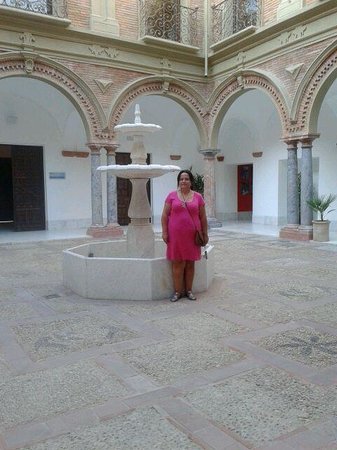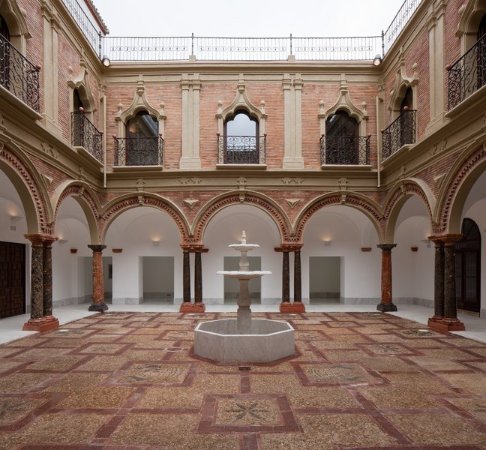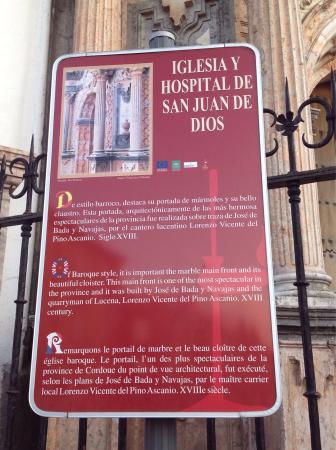Top 10 Things to do in Lucena, Spain
Discover the best top things to do in Lucena, Spain including Sanctuary of Our Lady of Araceli, Church of San Mateo, Castillo del Moral, Church of Santiago, Ruta Perla de Sefarad, Palacio de los Condes de Santa Ana, Museo Bodega El Alfoli, Convent of San Juan de Dios, Necropolis Judia, Church of Santo Domingo.
Restaurants in Lucena
1. Sanctuary of Our Lady of Araceli
Overall Ratings
4.5 based on 71 reviews
Reviewed By BennyMalaga - Malaga, Spain
High on the hill that overlooks the city of Lucena is the Hermitage of Our Lady of Araceli, the patron saint of Lucena. Its address is Calzada, 16. The sculpture was brought from Rome by the Marques de Comares. The hermitage was constructed in the 18th century in a Baroque design. There is a magnificent view of the countryside from the hermitage, and one can see five provinces, namely Malaga, Cordoba, Seville, Granada and Jaen. On clear days one can see the Moroccan coastline. There is a pilgrimage bringing the statue of the Virgin down to the Church of San Mateo during spring, and it is returned to the Hermitage about a month later.
2. Church of San Mateo
Overall Ratings
4.5 based on 58 reviews
Reviewed By BennyMalaga - Malaga, Spain
The Church of San Mateo is located at Plaza Nueva. The noble Diego Fernandez de Cordoba ordered the construction of the Church of San Mateo. It was started in 1498 and finished in 1544, with three naves. The original style was late Gothic, with Plateresque influences in the doors. The pillars look like they are Renaissance in style. The main door (Puerta de la Virgen) has a Renaissance style and is attributed to the architect Hernan Ruiz, done around 1550. There is a square tower with a spiral stairway to the top, and the tower contains five bells. The main design of the church today is Baroque.
The main altarpiece was created in Sevilla by the sculptor Juan Bautista Vazquez El Viejo and the architect Jeronimo Hernandez. In the 17th and 18th century, this was gilded by Antonio Mohedano. This altarpiece has five levels and is one of the most impressive in Spain. The design of the altarpiece was meant to instruct the people about the Bible. The lowest level has images of San Juan, San Lucas, San Marcos, San Mateo and Aser and Zacarias. The second level has scenes from the Annunciation, the Visitation, the Nativity, and the Epiphany. The third level has the presentation of Jesus in the temple, the flight to Egypt, Jesus among the doctors, the baptism of Jesus, the Assumption of the Virgin, the Eucharist, Christ praying in the field before His captivity, the captivity of Christ, Jesus before the public, and the Resurrection. The highest level has figures of Christ on the cross, Christ taken down from the cross, the burial of Christ, the Prophets, and the Virtues.
The chapel of the tabernacle construction was began in 1740 by the architect and painter Fernando Recio Chacon de Rojas, but he died in 1745 before its completion. The sculptor Pedro de Mena Gutierrez and the painter Jeronimo Lopez took charge in finishing the chapel in 1772. The outside of the chapel shows a simple design in the form of an octagon as a base. Above the base is a circular structure with seven windows. There is a stunning entrance of encrusted marble and the inside of the chapel is full of light. The cupola is covered with white plaster moldings in a very geometric design. It is filled with forms of flowers, acanthus leaves, and angels. On side panels one can find sculptures of the Evangelists. There are three large paintings by Juan de Dios Hernandez. The tabernacle is made of wood that has been gilded and measures 7 meter high and has a Rococo design. It has a canopy with sculptures by Pedro de Mena, decorated with scenes from the life of Christ. The centerpiece is a statue of the Immaculate Conception. This Baroque chapel, with its tabernacle, is one of the most stunning in Spain. Today the church is a National Monument.
3. Castillo del Moral
Overall Ratings
4 based on 48 reviews
Reviewed By BennyMalaga - Malaga, Spain
This castle was built by the Moors in the 9th century, possibly over an original Roman fort. In 1240 the Christian King Fernando II conquered the city and the castle. The soldier and noble Fernandez de Cordoba was associated closely with the castle. The castle is now in the center of the city in the Plaza de España. It has four towers in a large square floor plan, a large patio, and very thick walls. There is a Torre del Moral and a Torre de las Damas. There is a legend that the castle was used to imprison the Nazarite King Boabdil, El Chico.
Today the castle has the local office of tourism. On the upper floors one can find the Museo Arqueologico y Etnologico. This museum contains all the past of Lucena, from coins, pottery, ceramics, and metal objects, all found in the environs of the city. There are ten salons where these are displayed. Of particular interest is the Jewish salon, where there are objects of the Jewish culture from the past. There is also the Cueva del Angel, which is a simulated cave showing the life of Neanderthals. This is one of the best museums of its kind in Andalusia.
4. Church of Santiago
Overall Ratings
4 based on 14 reviews
Reviewed By BennyMalaga - Malaga, Spain
This church located on Calle Santiago was built in the Gothic/Mudejar style in the 16th century.
The Commander of the Order of Santiago was Garci Mendez de Sotomayor and he ordered the church to be built in 1503. The church has a rectangular floor plan with three naves. There are octagonal pillars that support pointed arches. The main front door carries an image of Santiago (St. James), the patron saint of Spain. The church has been declared as a National Historic Monument.
5. Ruta Perla de Sefarad
Overall Ratings
4.5 based on 8 reviews
Reviewed By RUDIB1 - PARIS
Un bâtiment superbe qui abrite des expositions très bien présentées. Si on s'intéresse au passé de Lucena, il faut également se rendre au cimetière juif qui a été exhumé il y a peu. Pour cela, demander une visite guidée au château dépendant de la mairie
6. Palacio de los Condes de Santa Ana
Overall Ratings
4 based on 9 reviews
Reviewed By PPCI-BG - Italy
Bel palazzo barocco del Settecento che adesso ospita varie mostre e il “centro d’interpretazione” della città. Le esposizioni sono varie ma è bella soprattutto l’architettura del plazzo con una ricca facciata e due patios. Quello con doppie colonne ha un decoro che mi è piaciuto molto. Merita la visita.
7. Museo Bodega El Alfoli
Overall Ratings
5 based on 3 reviews
Reviewed By Mc R - Lucena, Spain
Lugar mágico ubicado en el centro de la localidad . Recoge tradición, sabor.
Ofrece distintas experiencias relacionadas con el vino. Catas de vino, con o sin aperitivos.
Marinaje con Musica y un programa variado.
Cuenta con un pequeño museo de antigüedades todas propiedad de la familia.
Hay que llamar para concertar las visitas.
Todas las visitas son guiadas
8. Convent of San Juan de Dios
Overall Ratings
4 based on 5 reviews
Reviewed By BennyMalaga - Malaga, Spain
The Convent of San Juan de Dios is located at Calle de la Calzada, 16. It is the third convent of the Orden Hospitalaria de San Juan de Dios and was founded in 1565 by Frutos de San Pedro, a brother from the same order in Granada. In the 18th century a son of Lucena became the head of the order and had the convent enriched. The Baroque church has one nave only and this is adorned with marble and jasper. The main altar was finished in 1754. The architect was Jose de Bada y Navajas. He hired the artists Raxis, Saravia, Bocanegra and Alonso Cano to decorate the interior of the church. The crypt has the remains of Frutos de San Pedro who is in the process of being beatified. Today the convent is part of a rest home for old people, but one can ask the authorities of the rest home to see the church.
9. Necropolis Judia
Overall Ratings
4.5 based on 2 reviews
Reviewed By es_eltigre - Almeria, Spain
Fuimos con la visita guiada contratada en la oficina de Turismo, La guia, Araceli, nos explico con todo lujo de detalles como se descubrio, como se supo lo que era, y como se realizaron las exhumaciones y posterior enterramiento. Es muy interesante el conocer el mundo judeo-sefardita a traves de esta necropolis.
10. Church of Santo Domingo
Overall Ratings
4 based on 4 reviews
Reviewed By BennyMalaga - Malaga, Spain
The Church of Santo Domingo is located at Juan Jiménez Cuenca, 14. It was built over a hermitage dedicated to San Francisco de Paula in 1730. Its architect was Fray Juan Rodriguez de Ocampo. The church has a Latin Cross design, with lateral chapels. There are two doors to the church, one dedicated to San Francisco de Paula, and the other to the Virgen de la Victoria. The beautiful main altar in Baroque design was made by Francisco Jose Guerrero, who also created the plaster molds that decorate the cupola. There is a statue of Christ of the Blood that was made of acacia in Mexico. The statue of San Jose was made by the sculptor Jose de Mora from Granada. The statue of San Marcos is attributed to Jose de Medina.










